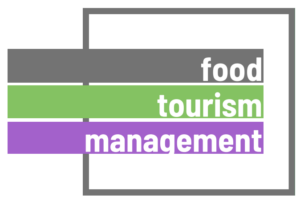This website uses cookies so that we can provide you with the best user experience possible. Cookie information is stored in your browser and performs functions such as recognising you when you return to our website and helping our team to understand which sections of the website you find most interesting and useful.
Impact of Food Tourism
advantages for destinations?
The following blog post is about the journey of Laureen Rashof in becoming a food tourism manager her own business.

The impact of food tourism should be understood by all destination stakeholders due to its global growth rate of 17.4% per year. Considering its inclusion in a destination’s general tourism strategy can alone be justified by its projected market value of US$ 1,796.5 billion in 2027 (Wood, 2022).
Increasing tourist numbers due to food tourism
Food tourism enables the opportunity to build up attractions and events involving local and regional food. If it is combined with the element of experience, more and more tourists are attracted, and tourist spending increases (Taks et al., 2009). As food tourism can be seen as a driving force of economic growth, it is necessary to be aware about the development’s economic values (Hjalager & Richards, 2002).
Generally, food tourists spend about 25% of their travel budget on food and beverages. This can lead to a rise in the local community’s profits. Also, due to the taxes on the products purchased, the local government’s budget is supported (UCF, n.d.).
the impact of Food tourism strengthens the local economy
More employees are needed in the food industry to keep up and to satisfy the rising demand. Hence, the higher the demand for local food, the higher the demand for employment (Sormaz et al., 2016). Especially in rural areas with low economic activity more job opportunities arise (UCF, n.d.).
Consequently, this increase in revenue enables local governments to invest in tourism marketing. This would mean a boost for local restaurants, shops, accommodations and transportation services. Furthermore, a rise in food tourism can foster locals’ cultural pride (UCF, n.d.). Those social influences will be pointed out in another article.
Regional destination development as impact of food tourism
Not only the tourism industry but also the agricultural industry of the destination will be strengthened through food tourism (Schmit & Hadcock, 2012). In particular, food tourism products and experiences encase a destination’s natural and cultural aspects (e.g. how to harvest and process regional grapes) (Fusté Forné, 2015). This is how food tourism adds value to agricultural products (Quan & Wang, 2004). As food and agriculture are connected, an inter-sectoral multiplier effect will be created (Lorenzini, 2011).
Moreover, due to the increased support for local and regional agricultural products, food turned out to be the new prescription for economic diversification. It fosters the development of rural and regional areas (Hall & Gössling, 2016).
Managing food tourism sustainably
If food tourism shall support the regional development of a destination, it is essential to involve local stakeholders instead of international chains. The goal should be to prevent the leakage effect, so that tourism generated revenue remains in the local economy (Telfer & Wall, 1996). Furthermore, food tourism enables possibilities to support environmental sustainability (Schmit & Hadcock, 2012). The cooperation between suppliers such as restaurants and local farmers creates a sustainable agriculture as well as a varied, strong food economy (Bachmann, 2004).
To maximise the positive impact of food tourism, local governments and businesses should employ well-educated professionals in hospitality and tourism management. Those experts are able to educate all stakeholders about the correct management of food tourism. This is how the negative influence on local communities can be mitigated (UCF, n.d.).
In conclusion, food tourism does not only strengthen the tourism industry. Rather, it boosts the entire economy. New jobs are created and the regional development benefits. In order to take advantage of the positive impact of food tourism, it is important to hire knowledgeable food tourism experts.
If you want to find out the potential impact of food tourism on your destination, contact me.
Laureen Rashof, 29.03.2022
Sources
Bachmann, J. (2004) Selling to restaurants: Business and marketing. Retrieved from https://attra.ncat.org/publication.html
Fusté Forné, F. (2015). El turisme gastronòmic: Autenticitat i desenvolupament local en zones rurals. [Gastronomic tourism: Authenticity and local development in rural areas]. Documents d’Anàlisi Geogràfica, 61(2), 289–304. Retrieved from https://dag.revista.uab.es/article/view/v61-n2-fuste
Hall, C. M. & Gössling, S. (2016). Food tourism and regional development: Networks, products and trajectories. Abingdon, England: Routledge.
Hjalager, A.-M. & Richards, G. (2002). Tourism and gastronomy. London, England: Routledge
Lorenzini, E. (2011). The extra-urban cultural district: An emerging local production system. Three Italian case studies. European Planning Studies, 19(8), 1441-1457. doi:10.1080/09654313.2011.586179
Quan, S., & Wang, N. (2004). Towards a structural model of the tourist experience: An illustration from food experiences in tourism. Tourism Management, 25(3), 297-305. doi:10.1016/s0261-5177(03)00130-4
Schmit, T. M., & Hadcock, S. E. (2012). Assessing barriers to expansion of farm-to-chef sales: A case study from upstate New York. Journal of Food Research, 1(1), 117–125. doi:10.5539/jfr.v1n1p117
Sormaz, U., Akmese, H., Gunes, E., & Aras, S. (2016). Gastronomy in tourism. Procedia Economics and Finance, 39, 725-730. doi:10.1016/s2212-5671(16)30286-6
Taks, M., Chalip, L., Green, B. C., Kesenne, S., & Martyn, S. (2009). Factors affecting repeat visitation and flow-on tourism as sources of event strategy sustainability. Journal of Sport & Tourism, 14(2-3), 121-142. doi:10.1080/14775080902965066
Telfer, D. J., & Wall, G. (1996). Linkages between tourism and food production. Annals of Tourism Research, 23(3), 635-653. doi:10.1016/0160-7383(95)00087-9
UCF (n.d.). Food tourism: The impact of food tv shows on local industries. Retrieved from https://www.ucf.edu/online/hospitality/news/food-tourism/
Wood, L. (2022). Global culinary tourism market (2022 to 2027) – industry trends, share, size, growth, opportunity and forecasts. Retrieved from https://www.globenewswire.com/news-release/2022/02/02/2377627/28124/en/Global-Culinary-Tourism-Market-2022-to-2027-Industry-Trends-Share-Size-Growth-Opportunity-and-Forecasts.html
